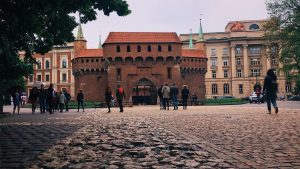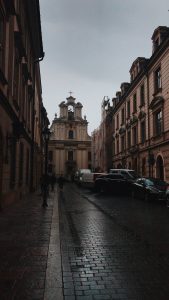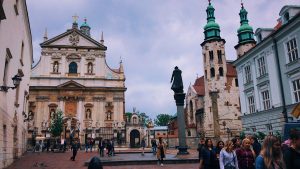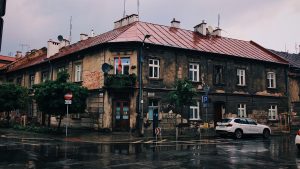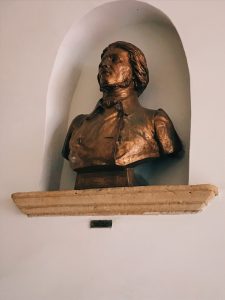The tour in the morning and afternoon in Kraków helped contextualize the Polish kingdom and Polish Jewry as well as reinforced the theme of memory culture. Early in the semester, we discussed the Polish hierarchy of the peasants, serfs, szlachta (i.e. the Polish nobility), and magnates. We were able to see and discuss feudal structures such as the fortresses and moats that protected the city from invaders, and town squares like Rynek Główny where people conducted legislative and economic activity. There were many historical churches around the town, which demonstrates how religion, specifically Christianity, is intertwined with Polish identity. We also saw monuments referring to the Czartoryski family, who belonged to the peak of the feudal hierarchy. If there were any old taverns or establishments that were run by Jews around the 17th-18th century, it would have been nice to visit them because we discussed at length concerning their socioeconomic status. As the tour progressed, the prevalence of certain monuments demonstrated what contemporary Poles place importance on. For example, key figures discussed during the tour were Polish King Kazimierz the Great and Adam Mickiewicz. The Jewish quarter Kazimierz was named after the king; murals and other art honoring him can be observed throughout the town. His memory lives on because of his acceptance of Jews by giving them various privileges. Similarly, Adam Mickiewicz’s presence is ubiquitous in Kraków because of his literature that promotes Polish nationalism. In the evening in Kraków, the tour focused more modern history of Poland regarding Jewish ghettos and the World War II era. Gratefully, we were able to visualize the preserved Jewish ghetto in the district of Podgórze due to it not being destroyed by Nazi’s during the regime. We were able to walk the same streets of those who lived in the ghetto and see the same historic buildings that were used during the time. Every step we we took was spurring with history and it was truly an astounding walk into the past. From old synagogues to the building that held the JCO, we were truly able to feel the reality and significant ambiance of it all. Even our tour guide had family lineage from the district and this only made it more real for us to conceptualize. One of the most important aspect of this tour was realizing how legitimate Poland’s Jewish history is. The fact that we had the ability to follow the same path across a bridge the Jews crossed to get into Podgórze, and standing in the middle of a quarter where Jews would line up to obtain cards from S.S. soldiers who gave them leniency from boarding trains to prison camps was a surreal experience. We also heard about a story of a man who worked in a pharmacy right outside of the place where the final liquidation of the ghetto occurred and Jews were rounded up. He was an honorable man who had conversations with the Jews of the district, who later commemorated Jews that were senselessly killed, and even snuck some through his shop to safety. Recognizing those who were killed and how some had their lineage ended right on that very day, he wrote about them and their life story in a now historical piece that granted peace to some victims’ families and honored those who had passed. It’s one thing to read about all these events on paper, but it’s another to see it in person.
